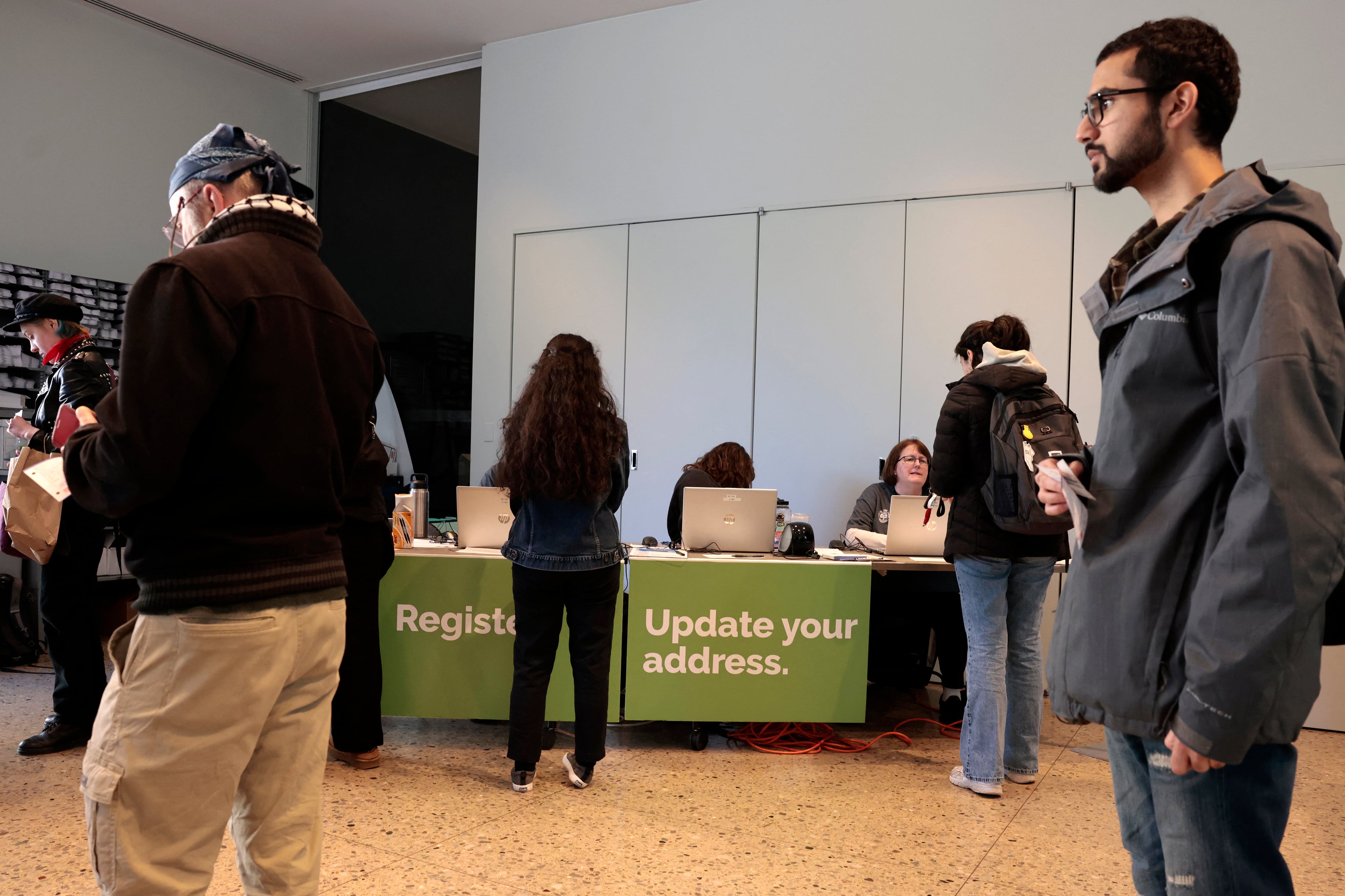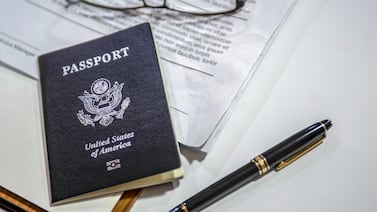Votebeat is a nonprofit news organization reporting on voting access and election administration across the U.S. Sign up for Votebeat Michigan’s free newsletter here.
The city of Ann Arbor recorded one of the state’s highest rates of early in-person voting in the February primary, and a Votebeat analysis shows it also succeeded in another important measure: It kept the cost per vote low.
Ann Arbor spent about $19 per early in-person vote, among the lowest of dozens of municipalities included in the analysis, which gauged only recurring costs like labor.
In Lansing, a city similar in size to Ann Arbor, the cost per vote was triple — around $58 — and the turnout rate much lower.
Meanwhile, in sparsely populated Ontonagon County in the Upper Peninsula, municipal election officials banded together under a countywide plan. Ontonagon County spent about $63 per vote, though that cost was spread among a dozen municipalities.
The Votebeat analysis examined different models of making early in-person voting available to determine which were most cost-efficient, and which led to the highest rate of early in-person voting. That’s the percentage of all voters in the primary who used the early in-person option.
The data did not reveal a clear, overarching pattern, but instead showed several trends that could offer insight for improving efficiency and boosting turnout.
The analysis also highlights the varied factors that can influence cost and turnout. Some are within clerks’ control, and others are not.
The February primary, notably, was a low-turnout election overall, with only 23% of registered voters casting ballots. And interest in early voting in some places hinged on unique factors, such as University of Michigan students in Ann Arbor with a strong interest in voting “uncommitted” in the Democratic primary and casting ballots before spring break, when election day fell.
In November, when far more people are voting, the cost per vote will probably go down. Meanwhile, as awareness of the early in-person option grows, more people will use it.
Clerks who spoke with Votebeat about the analysis stressed that voters by a wide margin approved a constitutional amendment guaranteeing an early in-person voting option, because they wanted to boost ballot access, regardless of cost.
It is “a mandated service that voters have told us they want,” said Ed Golembiewski, a former Washtenaw County deputy clerk.
“Implied within that is that they aren’t concerned that it costs more money, or the convenience of early voting offsets concerns about it costing more money,” Golembiewski added. “That said, we have a fiduciary responsibility to taxpayers, and election officials are efficient people by nature, so we’re certainly trying to provide this in a way that is cost effective, but also provides as much service to voters as we can.”
Among the analysis’ primary findings:
- While clerks all say partnering with neighboring municipalities reduces costs, it does not always produce a high early in-person voting rate or improve voting access.
- Among jurisdictions and municipalities that conducted their early voting themselves, the more populous ones typically had lower costs per vote than smaller municipalities.
- The costs and turnout rate for different municipalities and jurisdictions were likely influenced by a range of factors, including the number of early in-person vote sites, and how vigorously each clerk’s office promoted the option.
How Votebeat analyzed early voting costs
The February presidential primary marked the first statewide election in which Michigan adopted the new rules required by Prop 2, a 2022 ballot initiative approved by 60% of voters that aimed to expand voting access.
Among other provisions, it mandated nine days of early in-person voting. Local clerks can implement that with one of three approaches: run their own early voting setup, cooperate with neighboring municipalities, or enter into a countywide arrangement, in which county election officials coordinate the process and strategically distribute polling places.
The analysis estimated the cost per vote based on the number of early in-person votes cast and the operating costs that clerks will incur each election, such as poll worker wages and some supplies. State law and the election manual require two election workers to be present at each location for 10 hours per day, though some were open for 12 hours.
Because this was Michigan’s first election with early in-person voting offered statewide, Votebeat’s analysis of cost per voter offers a unique data point without a comparable benchmark. Election day voting — given the higher volume of voters — will tend to be more cost efficient.
Nonetheless, the numbers provide an initial data point for officials to explore the most effective early voting approach in future elections.
The analysis did not factor in upfront costs for equipment like tabulators, computers, or software. The vast majority of those costs were covered by a one-time, $30 million allotment from the Legislature.
The Legislature’s allotment also covered much of municipalities’ poll worker costs for 2024, but it is unclear whether the state will continue that in 2025 and beyond.
Votebeat compared costs and turnout rates for a range of jurisdictions. Some were large, urban centers, like Lansing and Ann Arbor, each with electorates of more than 70,000 voters. Others were smaller communities that coordinated the early voting on their own, such as rural Bridgewater Township in Washtenaw County, and Harrison Township in Macomb County, each having fewer than 2,500 voters.
Some smaller communities banded together in a larger jurisdiction, as in Washtenaw County, or rural Ontonagon County. Some of Michigan’s largest jurisdictions, such as Detroit and Macomb County, did not respond to Votebeat’s requests to provide their cost numbers.
Joining forces vs. going it alone
Clerks say it is more cost effective for smaller municipalities to partner with neighboring communities to form larger early-voting jurisdictions, because the arrangement offers economies of scale, especially in administrative costs. Communities that share voting sites need fewer places than if each opened their own, which significantly lowers labor costs.
The benefits can be seen in Washtenaw County, where 23 municipalities joined forces under a jurisdiction that spent about $16.72 per vote, the second lowest cost in the analysis. By contrast, two municipalities in the county that opted not to join the countywide jurisdiction had much higher costs: $44 per vote in Ypsilanti Township, and $86 in Bridgewater Township.
Bridgewater, though, did see a relatively high rate of early in-person voting, suggesting that proximity to an early voting site is helpful, if costly, for small municipalities. Milan, which spent $73 per voter, saw a similar effect.
In Ingham County, which includes much of Lansing, most municipalities chose to go it alone. It would have been more cost efficient for many of the smaller townships and cities to work together, said Ingham County Clerk Barb Byrum. Such partnerships could save hundreds of thousands of dollars statewide, she added.
“I’m glad to see some of them partner up, but I wish more of them would,” Byrum said.
However, the partnerships may not improve access. In Ingham County, three municipalities worked together: Vevay Township, Onondaga Township, and Aurelius Township. For Byrum, who lives in that area, that meant driving at least 15 minutes to her early-vote location, which was farther than her local township hall where the early in-person vote would have happened had the township run its own site.
“Requiring a 15-minute drive did not make it more accessible,” she added.
One factor influencing how clerks decide to operate is whether they are full time. Many in smaller communities are not, and that forces them to work as part of a larger jurisdiction. Ontonagon County consolidated its early voting because of that challenge, said McMillan Township Clerk Kay Richter.
Even though the partnership was designed to limit costs, Richter didn’t think the result was worth it. The county served 71 early voters, at a cost of $63 per vote.
“It was a total waste of time, energy, and money to run an EV site in Ontonagon County,” Richter said. “I highly doubt that it increased total voter turnout for the primary. In my opinion, we paid people to sit and do almost nothing for nine days.”
In Ann Arbor, the high turnout rate highlights how decisions made by clerks can boost turnout while keeping the cost per vote relatively low. The city offered six in-person voting sites, which pushed its labor costs up to about $50,000, City Clerk Jacqueline Beaudry said.
The city partnered with the University of Michigan and Ann Arbor District Library, and located voting sites where there is a high volume of public traffic, including in the mornings and evenings, when people typically vote.
“A large part of our success was location, and our plan was ‘What is best for our voters?’” Beaudry said. “We were all around the community at different times, so whatever worked best for the voter, we were there for them.”
Ann Arbor’s turnout may also have benefited from the timing of U-M’s spring break, which occurred during the week of the Feb. 27 election. Many students were not going to be on campus on that day, which likely boosted participation in early voting. The interest among some U-M students to cast a ballot for “uncommitted” as a protest vote against President Joe Biden’s policy in the Israel-Hamas war may have also factored into the high tally.
By contrast, East Lansing, home to Michigan State University, had a relatively low early-voting turnout and the highest cost in Votebeat’s analysis, at about $119 per vote. MSU’s spring break was at the same time as U-M’s, and the city offered an early in-person voting site on campus. East Lansing City Clerk Marie Wicks did not respond to a request for comment.
Byrum, the Ingham County clerk, said clerks will figure out how to balance cost efficiency and boost access as they get more experience with the early in-person voting option, and voters become aware of it.
“We have to figure out a way to make sure that an early vote site is accessible to voters while keeping in mind personnel restraints on our smaller townships and cities,” she said. “And we need to figure out which agreements best serve our voters.”
Votebeat contributor Tom Perkins is a freelance reporter in Hamtramck, Michigan.




